
The Gulf of St. Lawrence fringes the shores of the provinces of Quebec, New Brunswick, Nova Scotia, Prince Edward Island, Newfoundland and Labrador, in Canada, plus the islands Saint-Pierre and Miquelon, possessions of France, in North America.

Cap-de-la-Madeleine is a former city in Quebec, Canada at the confluence of the Saint-Maurice River and the St. Lawrence River. It was amalgamated into the City of Trois-Rivières in 2002. Population 33,022.
Portneuf County is a historic county in Quebec, Canada west of Quebec City on the Saint Lawrence River in Canada.

Les Îles-de-la-Madeleine is a municipality located in Gaspésie-Îles-de-la-Madeleine region, in Quebec, Canada. The islands of the archipelago and the municipality are geographical and political versions of the same entity.
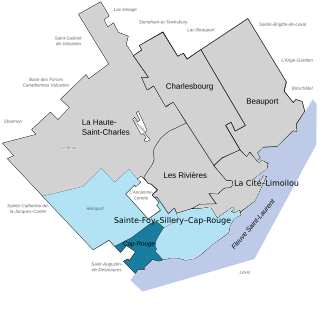
Cap-Rouge is a former city in central Quebec, Canada, since 2002 within the borough Sainte-Foy–Sillery–Cap-Rouge in Quebec City. The site of the first attempted permanent French settlement in North America, Charlesbourg-Royal, is located at the confluence of the Rivière du Cap Rouge and the Saint Lawrence River. Its population was 13,153 as of the Canada 2011 Census.

Old Quebec is a historic neighbourhood of Quebec City, Quebec, Canada. Comprising the Upper Town and Lower Town, the area is a UNESCO World Heritage Site. Administratively, Old Quebec is part of the Vieux-Québec–Cap-Blanc–colline Parlementaire district in the borough of La Cité-Limoilou.

Maizerets is a neighbourhood of the la Cité-Limoilou borough of Quebec City, Quebec, Canada that had a population of 14 700 in 2011.
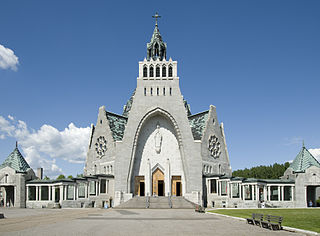
The Basilica of Notre-Dame-du-Cap is a minor basilica in Trois-Rivières, Quebec, Canada. It is Canada's national shrine to the Blessed Virgin Mary, and one of six national shrines in Canada. Each year, the site is visited by thousands of Catholic pilgrims.

The Seminary of Quebec is a Catholic community of diocesan priests in Quebec City founded by Bishop François de Laval, the first bishop of New France in 1663.

The Quebec rockslide occurred on September 19, 1889, after a day of heavy rain in Quebec City, Canada. An overhanging piece of slate rock broke off from Cap Diamant and fell 90 metres onto the houses below. The homes of 28 families on Champlain Street were crushed, burying roughly 100 people under 24 metres of broken slate rock. The final death toll exceeded 40 people.

Laniel is an unorganized territory in the Témiscamingue Regional County Municipality, Abitibi-Témiscamingue region, Quebec, Canada. It surrounds the northern portion of Lake Kipawa.
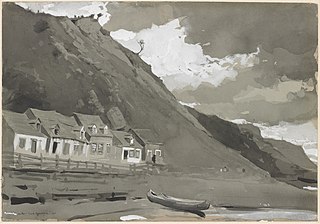
Anse au Foulon is a small cove in Quebec, Canada. It was located about one and one-half miles above Quebec City, in the formerly independent town of Sillery, until 1 January 2002, as part of the 2000–06 municipal reorganization in Quebec. Since that date, Anse au Foulon and Sillery have been officially located in Quebec City.
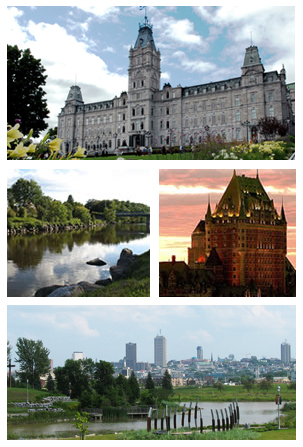
La Cité-Limoilou is the central borough of Quebec City, the oldest, and the most populous, comprising 21.85% of the city's total population. As an administrative division, it is very new, having only been formed on November 1, 2009, from the former boroughs of La Cité and Limoilou.
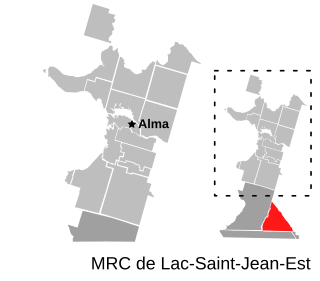
Lac-Achouakan is an unorganized territory in the Canadian province of Quebec, located in the regional county municipality of Lac-Saint-Jean-Est. It had a population of zero in the Canada 2006 Census, and covered a land area of 227.35 km2, entirely within the Laurentides Wildlife Reserve. The western boundary of the territory is Bark River, while Quebec Route 169 forms the eastern boundary.

Our Lady of the Cape is a title given to Mary the Mother of God in Cap-de-la-Madeleine, Quebec Canada. The title refers specifically to a statue of the Blessed Mother which is currently located in the Old Shrine.

In Quebec City, the term promontory of Quebec refers to the area on which is built the upper part of the borough of La Cité-Limoilou, including Old Quebec. This area covers the eastern half of a larger plateau attested in French as colline or even plate-forme de Québec. The western portion of this plateau is occupied by upper Sainte-Foy–Sillery–Cap-Rouge.
The River Schooners is a 1968 Canadian documentary, produced by the National Film Board of Canada and directed by Pierre Perrault. The third and final film in his "Île-aux-Coudres Trilogy" after Pour la suite du monde and The Times That Are , the film portrays workers in L'Isle-aux-Coudres, Quebec, who are employed in the traditional but fading art of building wooden schooners.
Loups Marins River is a river in the Côte-Nord region of Quebec, Canada. It empties into the Gulf of Saint Lawrence.

Le Diamant Theatre is a large-scale performing arts venue in the center of Québec City, Québec, Canada. Coarchitecture, In Situ, Jacques Plante Architects, OPI, Trizart Alliance, and Tetra Tech were chosen as the project's primary architects and structural designers to meet Quebec City's expanding needs for leisure, entertainment, and urban development. Le Diamant unifies traditional and modern architecture with the use of glass and asymmetrical design. The theater is located at the intersection of Rue des Glacis and Rue Saint-Jean, across from the historic square, Place D'Youville, in Quebec City's Saint-Roch neighborhood. Le Diamant Theatre was built over the course of three years by the Canadian construction company Pomerleau Inc., and it opened its doors in June 2019. Le Diamant Theatre was constructed for a total cost of $54 million, with an additional $10 million from the Quebec government, and the remaining money coming from private funding. New meeting rooms, offices, parking facilities, and a link between the upper and lower towns were all built as part of the project.
Saint-Sauveur is one of the 35 neighbourhoods of Quebec City, and one of the six that are situated within the borough of La Cité–Limoilou. It is one of the neighbourhoods which form the Lower Town of Quebec City. The neighbourhood is named after Jean Le Sueur.
















